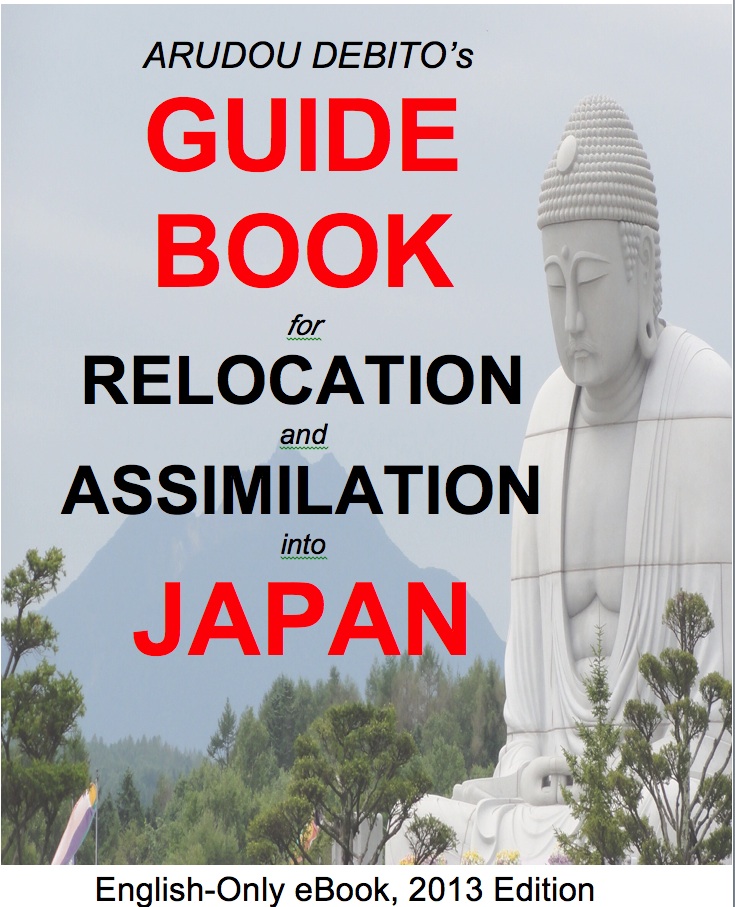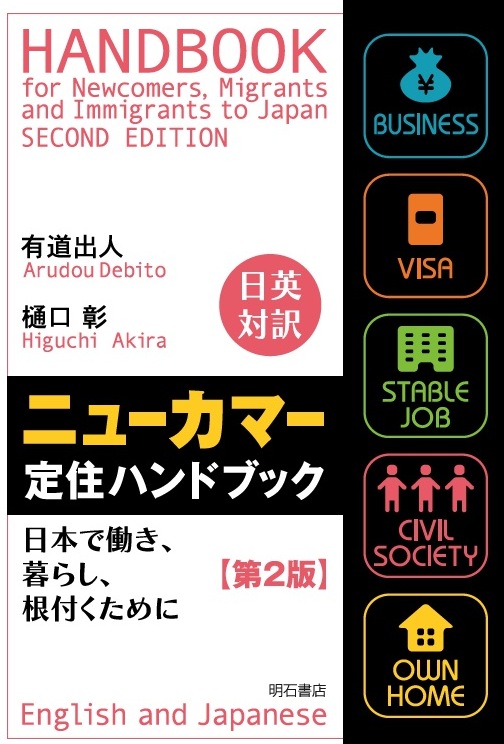mytest
Books, eBooks, and more from Dr. ARUDOU, Debito (click on icon):





![]()


UPDATES ON TWITTER: arudoudebito
DEBITO.ORG PODCASTS on iTunes, subscribe free
“LIKE” US on Facebook at http://www.facebook.com/debitoorg
https://www.facebook.com/embeddedrcsmJapan
http://www.facebook.com/handbookimmigrants
https://www.facebook.com/JapaneseOnlyTheBook
https://www.facebook.com/BookInAppropriate
If you like what you read and discuss on Debito.org, please consider helping us stop hackers and defray maintenance costs with a little donation via my webhoster:

All donations go towards website costs only. Thanks for your support!
Hi Blog. Here’s an article that is about a year and a half old, but it’s remarkable how much the landscape of the debate on immigration into Japan has not changed since. We have immigration proponent Sakanaka Hidenori (of whom I am a fan: I cite him extensively in book “Embedded Racism“, and deal with the arguments below in Ch. 10) meeting with people who are only concerned about money, and arguing that immigration is also important for them to keep their fix. Meanwhile, from a political standpoint, it is clear in the article below that Abe and his power elite aren’t really going to budge on the issue either: To them, foreign residents are merely temporary workers, who should come here and contribute but not expect a stake in their investments into this society. Not really news, I guess, but the issue is laid out so nakedly clear here, especially in the last half of the article. Have a read. Dr. ARUDOU, Debito
//////////////////////////////////
Success of ‘Abenomics’ hinges on immigration policy
BY REIJI YESHIVA, THE JAPAN TIMES MAY 18, 2014
http://www.japantimes.co.jp/news/2014/05/18/national/success-abenomics-hinges-immigration-policy/
In March, Hidenori Sakanaka, a former director of the Tokyo Regional Immigration Bureau, was contacted by — and met with — a group of people he had never dreamed of crossing paths with: asset managers from global investment firms.
Sakanaka, who now heads the Japan Immigration Policy Institute in Tokyo, was asked to explain Japan’s notoriously tight immigration policies and his proposal to drastically ease them to save Japan from the severe consequences of its rapidly aging and shrinking population.
Sakanaka said the asset managers showed strong interest in a remark made the previous month by Prime Minister Shinzo Abe, and that they were wondering if they should buy Japanese assets, such as stocks and real estate.
In February, Abe indicated he is considering easing Japan’s immigration policies to accept more migrant workers to drive long-term economic growth.
The asset managers reportedly included representatives from investment giants BlackRock Inc. and Capital Group.
“Global investors have a consistent policy of not investing in a country with a shrinking working and consumer population,” Sakanaka told The Japan Times.
“If the working population keeps shrinking, it will keep pushing down consumption and the country will be unable to maintain economic growth. In short, this means the growth strategies of ‘Abenomics’ can’t be successful without accepting immigrants,” Sakanaka said.
Abe is set to revamp in June the elusive “third arrow” of his economic program — structural reforms and subsidies that could boost Japan’s potential for mid- to long-term growth.
Whether drastic deregulation of immigration is part of the third arrow is something that both the public and the foreign investment firms want to know.
Japan’s population will dramatically shrink over the next five decades, from 117.52 million in 2012 to 87 million in 2060 — if the fertility rate doesn’t climb. The rate is expected to hover at 1.39 this year before dipping to 1.33 through 2024 and edging up to 1.35 for the foreseeable future.
Gross domestic product is expected to shrink accordingly, which could reduce the world’s third-largest economy to a minor player both economically and politically, many fear.
“Whether to accept (more) immigrants or not is an issue relevant to the future of our country and the overall life of the people. I understand that (the government) should study it from various angles after undergoing national-level discussions,” Abe told the Lower House Budget Committee on Feb. 13.
On May 12, members of a special government advisory panel on deregulation proposed creating six special regions where visa regulations would be eased to attract more foreign professionals and domestic helpers and baby sitters to assist them.
The daily Nikkei reported the government is likely to insert visa deregulation for certain types of foreigners in the Abenomics revamp due in June, but how many he is willing to let in remains unclear.
The conservative politician has so far appeared reluctant to promote heavy immigration and risk transforming Japan’s stable but rather rigid and exclusive society.
Abe has argued Japan should give more foreigners three- to five-year visas rather than let a massive number of immigrants permanently settle in Japan.
“What are immigrants? The U.S. is a country of immigrants who came from all around the world and formed the (United States). Many people have come to the country and become part of it. We won’t adopt a policy like that,” Abe said on a TV program aired April 20.
“On the other hand, it is definitely true that Japan’s population will keep shrinking and Japan will see a labor shortage in various production fields,” Abe said, adding he will consider easing regulations on issuing three- to five-year visas.
“It’s not an immigrant policy. We’d like them to work and raise incomes for a limited period of time, and then return home,” Abe said.
Among the core supporters of LDP lawmakers, including Abe himself, are nationalistic voters opposed to welcoming large numbers of unskilled foreign laborers, who are now barred from Japan. They fear that bringing in such people would increase the crime rate and deprive Japanese of job opportunities in the still-sluggish economy. This concern seems to be shared by a majority of Japanese. According to a poll by the daily Yomiuri Shimbun in April, while 74 percent of the 1,512 polled said they believe population decline will hurt Japan’s economy and contribute to its decline, 54 percent said they opposed bringing in more foreigners versus 37 percent who backed the idea.
Two high-ranking officials close to Abe, speaking on condition of anonymity, have said they are aware that foreign investors are interested in potential changes in Japanese immigration policy.
But their main interest appears to be to keep foreign investors interested in Japan, and trading on the Tokyo Stock Exchange, rather than transform Japan into a multicultural society by accepting more immigrants.
One of the two officials has repeatedly suggested he is paying close attention to foreign investors, pointing out that it is they, not Japanese investors, who have been pushing up stock prices since Abe took office in December 2012.
“We won’t call it an immigration policy, but I think we should accept more foreign workers,” the official said in February.
Hiking immigration is a sensitive issue for the conservative Liberal Democratic Party, the official said. But the idea of using them to fill shortages in medical, nursing, child care, for example, would be more palatable to such politicians, the official added.
Abe’s call for more short- to midterm migrant workers might help the short-handed construction, medical and nursing industries, among others. But it is unlikely to solve Japan’s long-term population crisis.
Junichi Goto, professor of economics at Keio University and an expert on immigration issues, said few people are opposed to bringing in more foreign professionals to reinvigorate the economy and that deregulation is urgently needed.
When it comes to unskilled workers, however, Goto is opposed to flooding Japan with cheap labor and says that a national consensus on the issue hasn’t been formed yet.
According to Goto’s studies and simulations, bringing in low-wage, unskilled foreigners would benefit consumers by pushing down domestic labor costs and thus prices for goods and services, thereby boosting consumption. On the other hand, he says the cost of domestic education, medical and other public services would rise.
The benefits of bringing in foreigners will far outweigh the demerits, unless Japan ships them in by the millions, Goto’s study says.
“If the Japanese people wish to accept millions of foreign workers, that would be OK. But I don’t think they are ready for such a big social change yet,” Goto said.
Instead, Goto argued that Japan should first encourage more women and elderly to work to offset the predicted shrinkage. It should then ease regulations to lure foreign professionals rather than unskilled laborers, and reform the rigid seniority-based wage system to make it easier for midcareer foreigners to enter the labor market, Goto said.
At any rate, the rapid demographic changes now hitting Japan are unlikely to leave much time for the people to make a decision.
The proportion of seniors 65 or older will surge from 24 percent to as much as 39.9 percent in 2060, raising the burden on younger generations to support social security.
The Japan Policy Council, a study group of intellectuals from various fields, estimates that in 2040, 896 of Japan’s municipalities, or virtually half, will see the number of women in their 20s and 30s decline by more than half from 2010 as they flock to big cities.
Such municipalities “could eventually vanish” even if the birthrate recovers, the group warned in a report May 8.
Sakanaka praised Abe’s February remarks, saying it is a significant change from Japan’s long-standing reluctance to accept foreign workers.
But if Abe decides to open Japan only to short-term migrants, rather than permanent immigrants, Abenomics will end in failure, Sakanaka warned.
ENDS
3 comments on “JT: Sakanaka argues success of ‘Abenomics’ hinges on immigration policy (old article from May 2014; not much has changed)”
There is an article about this in the Japan Times from January 6th.
I cannot see “nursing robots” as a solution.
Is it just Abe? I think it’s the entire Japanese population’s mindset, and Abe is just one person out of majority.
Reading this article, I had a few ‘palm to forehead moments’, especially when I saw this one,”“It’s not an immigrant policy. We’d like them to work and raise incomes for a limited period of time, and then return home,” Abe said.”
He wants to have his cake and eat it too. Bring in the ‘acceptable’ able bodied and able minded, pay them for their time, likely at a lower rate than a local, and then kick them to the curb when they’re no longer needed, or have needs themselves, and which the state would legislate against providing benefits anyway. The ‘gotten-rid of cheap in 2008/9’ Brazilians and Peruvians in Shizuoka and Aichi come to mind.
That little neuron in the Nagata-cho policy-making brains has never completed the synaptic circuit, the one that realizes that the very people they want to import like commodities are just that, people too. And they deserve to be treated like people. One would have hoped the element of humanity might have crept into those coal-dark LDP hearts, especially when faced with what is a certain demise of the nation on so many levels, but, alas, it hasn’t, it would appear. There are still only two groups in the world, (1) Japanese and (2) everyone else.
And guess which of those get to sit in the front of the bus, while the remainder get to sit ‘with their own kind’?